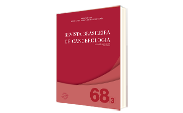Clinical Aspects and Prognostic Factors of Neuroblastoma: Case Report
DOI:
https://doi.org/10.32635/2176-9745.RBC.2022v68n3.2515Keywords:
neuroblastoma, prognosis, medical neoplasms, case reportsAbstract
Introduction: Neuroblastoma is an extracranial tumor originated from neural crest cell failures. It’s the most common malignant neoplasm among infants and it presents a very heterogeneous clinical profile. The objective of the article is to report the case of a patient with neuroblastoma in advanced stage and satisfactory survival, despite the poor prognostic factors. Case report: Female patient, 1 year and 4 months old who presented irritability, abdominal distention and intermittent fever with three months of evolution. In physical exam, she presented alopecia suggestive of trichotillomania, cervical, inguinal and axillary lymph node enlargement and abdominal distention. Abdominal computed tomography evidenced expansive mass, measuring 6.8 x 5.8 x 4.0 cm, located in the left anterior pararenal space. Bone scintigraphy and nuclear magnetic resonance showed images suggestive of distant secondary implants. After total tumor excision, it was confirmed poorly differentiated neuroblastoma, with non-amplified MYCN gene and unfavorable histology. Bilateral iliac crest biopsy revealed bone marrow areas occupied by the neoplasm, suggesting bone marrow infiltration. As this was a stage IV neuroblastoma, multimodal therapy was established with adjuvant chemotherapy after surgery, followed by autologous bone marrow transplantation, radiotherapy at the primary site of the lesion and at the sites of bone metastases and use of 13-cis-retinoic acid. Conclusion: Despite presenting several indicators of poor prognosis (age, stage IV, bone metastases, bone marrow infiltration), the patient has been in complete remission of the disease for 39 months.
Downloads
References
Whittle SB, Smith V, Doherty E, et al. Overview and recent advances in the treatment of neuroblastoma. Expert Rev Anticancer Ther. 2017;17(4):369-86. doi: https://doi.org/10.1080/14737140.2017.1285230 DOI: https://doi.org/10.1080/14737140.2017.1285230
Bom APKP, Deponte CS, Lima IC, et al. Neuroblastoma cervical: um relato de caso. Resid Pediatr. 2014;4(1):17-21. DOI: https://doi.org/10.25060/residpediatr-2014.v4n1-05
London WB, Castleberry RP, Matthay KK, et al. Evidence for an age cutoff greater than 365 days for neuroblastoma risk group stratification in the Children’s Oncology Group. J Clin Oncol. 2005;23(27):6459-65. doi: https://doi.org/10.1200/JCO.2005.05.571 DOI: https://doi.org/10.1200/JCO.2005.05.571
Conselho Nacional de Saúde (BR). Resolução nº 466, de 12 de dezembro de 2012. Aprova as diretrizes e normas regulamentadoras de pesquisas envolvendo seres humanos [Internet]. Diário Oficial da União, Brasília, DF. 2013 jun 13 [acesso 2020 set 14]; Seção 1:59. Disponível em: https://conselho.saude.gov.br/resolucoes/2012/Reso466.pdf
Lucena JN, Alves MTS, Abib SCV, et al. Aspectos clínicos, epidemiológicos e sobrevida de crianças com neuroblastoma: 21 anos de experiência do instituto de oncologia pediátrica, São Paulo. Rev Paul Pediatr. 2018;36(3):254-60. doi: https://doi.org/10.1590/1984-0462/;2018;36;3;00007 DOI: https://doi.org/10.1590/1984-0462/;2018;36;3;00007
Instituto Nacional de Câncer José Alencar Gomes da Silva [Internet]. Rio de Janeiro: INCA; [data desconhecida]. Neuroblastoma: versão para profissionais de saúde; 2022 jun 6 [atualizado 2022 jul 4; acesso 2020 set 14]. Disponível em: https://www.inca.gov.br/tipos-de-cancer/cancer-infantojuvenil/neuroblastoma/profissional-de-saude
Castleberry RP. Neuroblastoma. Eur J Cancer. 1997;33(9):1430-7; discussion 1437-8. doi: https://doi.org/10.1016/s0959-8049(97)00308-0 DOI: https://doi.org/10.1016/S0959-8049(97)00308-0
Golden CB, Feusner JH. Malignant abdominal masses in children: quick guide to evaluation and diagnosis. Pediatric Clin North Am. 2002;49(6):1369-92. doi: https://doi.org/10.1016/S0031-3955(02)00098-6 DOI: https://doi.org/10.1016/S0031-3955(02)00098-6
Swift CC, Eklund MJ, Kraveka JM, et al. Updates in diagnosis, management, and treatment of neuroblastoma. Radiographics. 2018;38(2):566-80. doi: https://doi.org/10.1148/rg.2018170132 DOI: https://doi.org/10.1148/rg.2018170132
Sokol E, Desai AV. The evolution of risk classification for neuroblastoma. Children (Basel). 2019;6(2):27. doi: https://doi.org/10.3390/children6020027 DOI: https://doi.org/10.3390/children6020027
Kushner BH. Neuroblastoma: a disease requiring a multitude of imaging studies. J Nucl Med. 2004;45(7):1172-88.
Cartum J. Variáveis de prognóstico em crianças maiores de um ano portadoras de neuroblastoma disseminado [tese na Internet]. São Paulo: Faculdade de Medicina da Universidade de São Paulo; 2010. doi: https://doi.org/10.11606/T.5.2011.tde-18022011-152029 DOI: https://doi.org/10.11606/T.5.2011.tde-18022011-152029
Berthold F, Boos J, Burdach S, et al. Myeloablative megatherapy with autologous stem-cell rescue versus oral maintenance chemotherapy as consolidation treatment in patients with high-risk neuroblastoma: a randomised controlled trial. Lancet Oncol. 2005;6(9):649-58. doi: https://doi.org/10.1016/S1470-2045(05)70291-6 DOI: https://doi.org/10.1016/S1470-2045(05)70291-6
Vollmer K, Gfroerer S, Theilen TM, et al. Radical surgery improves survival in patients with stage 4 neuroblastoma. World J Surg. 2018;42(6):1877-84. doi: https://doi.org/10.1007/s00268-017-4340-9 DOI: https://doi.org/10.1007/s00268-017-4340-9
Su Y, Wang L, Jiang C, et al. Increased plasma concentration of cell-free DNA precedes disease recurrence in children with high-risk neuroblastoma. BMC Cancer. 2020;20(1):102. doi: https://doi.org/10.1186/s12885-020-6562-8 DOI: https://doi.org/10.1186/s12885-020-6562-8
Published
How to Cite
Issue
Section
License
Os direitos morais e intelectuais dos artigos pertencem aos respectivos autores, que concedem à RBC o direito de publicação.

This work is licensed under a Creative Commons Attribution 4.0 International License.









